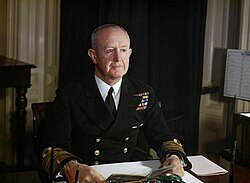Andrew Cunningham, 1st Viscount Cunningham of Hyndhope: Difference between revisions
m robot Adding: sr:Ендрију Канингем |
GrahamBould (talk | contribs) mNo edit summary |
||
| Line 2: | Line 2: | ||
[[Image:Andrew Browne Cunningham - Bronze bust at Trafalgar Square - London - 240404.jpg|thumb|right|250px|Bronze bust of Lord Cunningham, looking at Nelson's column and Whitehall]] |
[[Image:Andrew Browne Cunningham - Bronze bust at Trafalgar Square - London - 240404.jpg|thumb|right|250px|Bronze bust of Lord Cunningham, looking at Nelson's column and Whitehall]] |
||
[[Admiral of the Fleet]] '''Andrew Browne Cunningham, 1st Viscount Cunningham of Hyndhope''' ([[7 January]] [[1883]] |
[[Admiral of the Fleet]] '''Andrew Browne Cunningham, 1st Viscount Cunningham of Hyndhope''' ([[7 January]] [[1883]] - [[12 June]] [[1963]]), familiarly known as "ABC", was a famous [[United Kingdom|British]] [[admiral]] of [[World War II]], winning distinction in [[Mediterranean]] battles such as the [[Attack on Taranto]], [[Battle of Cape Matapan]] in [[1940]] and [[1941]], then serving as [[First Sea Lord]] from [[1943]] to [[1946]]. He was the older brother of General [[Alan Gordon Cunningham|Alan Cunningham]]. |
||
Cunningham joined the Royal Navy as a cadet aboard the training ship [[HMS Prince of Wales (1860)|HMS ''Britannia'']] in 1897. He was a highly decorated officer during the [[World War I|First World War]]. He was Commander-in-Chief, Mediterranean from 1939 to 1942, and in 1943. In this role Cunningham was involved in many naval encounters, most notably an aircraft carrier launched attack on the Italian fleet at Taranto destroying one Italian battleship and seriously damaging two others. The success of this attack may have been inspiration for the larger scale Japanese attack on Pearl Harbour later in the war. Cunningham was made Allied naval commander Expeditionary Force under [[Dwight D. Eisenhower|General Eisenhower]] in 1942, and served as [[First Sea Lord]] and Chief of Naval Staff from 1943-6. |
Cunningham joined the Royal Navy as a cadet aboard the training ship [[HMS Prince of Wales (1860)|HMS ''Britannia'']] in 1897. He was a highly decorated officer during the [[World War I|First World War]]. He was Commander-in-Chief, Mediterranean from 1939 to 1942, and in 1943. In this role Cunningham was involved in many naval encounters, most notably an aircraft carrier launched attack on the Italian fleet at Taranto destroying one Italian battleship and seriously damaging two others. The success of this attack may have been inspiration for the larger scale Japanese attack on Pearl Harbour later in the war. Cunningham was made Allied naval commander Expeditionary Force under [[Dwight D. Eisenhower|General Eisenhower]] in 1942, and served as [[First Sea Lord]] and Chief of Naval Staff from 1943-6. |
||
Revision as of 12:36, 25 July 2006

Admiral of the Fleet Andrew Browne Cunningham, 1st Viscount Cunningham of Hyndhope (7 January 1883 - 12 June 1963), familiarly known as "ABC", was a famous British admiral of World War II, winning distinction in Mediterranean battles such as the Attack on Taranto, Battle of Cape Matapan in 1940 and 1941, then serving as First Sea Lord from 1943 to 1946. He was the older brother of General Alan Cunningham.
Cunningham joined the Royal Navy as a cadet aboard the training ship HMS Britannia in 1897. He was a highly decorated officer during the First World War. He was Commander-in-Chief, Mediterranean from 1939 to 1942, and in 1943. In this role Cunningham was involved in many naval encounters, most notably an aircraft carrier launched attack on the Italian fleet at Taranto destroying one Italian battleship and seriously damaging two others. The success of this attack may have been inspiration for the larger scale Japanese attack on Pearl Harbour later in the war. Cunningham was made Allied naval commander Expeditionary Force under General Eisenhower in 1942, and served as First Sea Lord and Chief of Naval Staff from 1943-6.
He was made a Knight Commander of the Bath in 1939, and a Knight of the Thistle in 1945. In the same year he was elevated to the House of Lords as Baron Cunningham of Hyndhope, of Kirkhope, county Selkirk. In 1946 he was admitted to the Order of Merit and advanced to a viscountcy as Viscount Cunningham of Hyndhope. He acted as Lord High Steward at the coronation of Queen Elizabeth II in 1953. Upon his death without issue in 1963, both of these titles became extinct.
During the evacuation at the end of the Battle of Crete when Cunningham was determined that the "navy must not let the army down", when army generals feared he would lose too many ships, Cunningham famously said, "It takes three years to build a ship; it takes three centuries to build a tradition". The 'never say die' attitude of Cunningham and the men under his command meant that of 22,000 men on Crete 16,500 were rescued at the loss of three cruisers and six destroyers.
References
- Admiral A.B. Cunningham, A Sailor’s Odyssey (Hutchinson & Co, London, 1952)
- J. Winton, Cunningham: The Greatest Admiral since Nelson (London, 1998)
